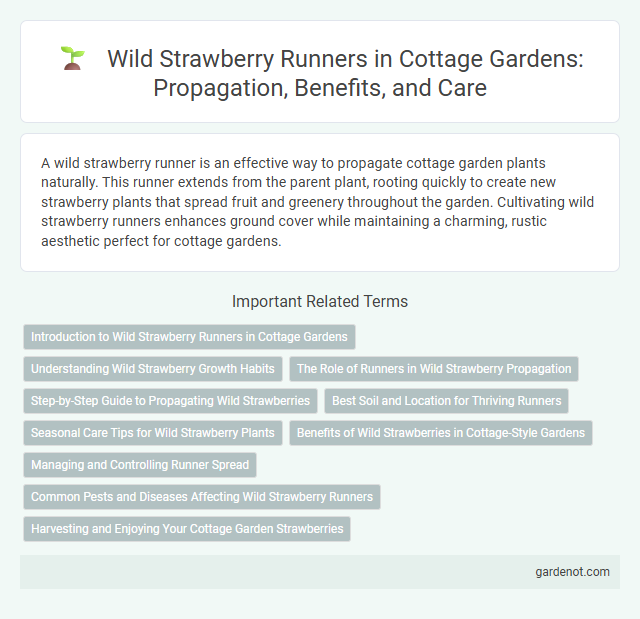A wild strawberry runner is an effective way to propagate cottage garden plants naturally. This runner extends from the parent plant, rooting quickly to create new strawberry plants that spread fruit and greenery throughout the garden. Cultivating wild strawberry runners enhances ground cover while maintaining a charming, rustic aesthetic perfect for cottage gardens.
Introduction to Wild Strawberry Runners in Cottage Gardens
Wild strawberry runners are essential for natural propagation in cottage gardens, offering a low-maintenance method to spread and establish new plants. These horizontal stems root at nodes, creating new wild strawberry plants that quickly fill gaps and enhance ground cover with lush green foliage and sweet, edible fruits. Incorporating wild strawberry runners encourages biodiversity and supports pollinators while adding charm and productivity to traditional cottage garden designs.
Understanding Wild Strawberry Growth Habits
Wild strawberry runners grow horizontally, producing new plants by sending out long, slender stems that root at nodes, effectively expanding the patch. Each runner can develop multiple daughter plants, enabling rapid ground coverage ideal for cottage garden settings. Understanding this growth habit allows gardeners to control spread, ensuring healthy, dense mats of wild strawberries that enhance soil stability and fruit yield.
The Role of Runners in Wild Strawberry Propagation
Wild strawberry runners play a crucial role in vegetative propagation by extending horizontal stems that root at nodes to form new plants, ensuring rapid colony expansion without seed production. These runners allow wild strawberries to efficiently colonize garden spaces, enhancing ground cover and stabilizing soil in cottage garden settings. Their ability to propagate clonally supports genetic uniformity, making them a reliable choice for gardeners aiming for consistent fruit quality and plant vigor.
Step-by-Step Guide to Propagating Wild Strawberries
Propagating wild strawberries involves selecting healthy runners that produce small plantlets at their tips, ensuring they have developed roots before transplanting. Gently pin the runner's plantlet to the soil surface using a small pin or stone to encourage root growth, keeping the soil moist but not waterlogged. Once the roots establish firmly, carefully sever the runner from the parent plant and transplant the young wild strawberry plant to a prepared spot in your cottage garden for optimal growth.
Best Soil and Location for Thriving Runners
Wild strawberry runners thrive best in well-drained, loamy soil rich in organic matter with a slightly acidic to neutral pH of 5.5 to 7.0. They prefer a sunny to partially shaded location that provides at least 6 hours of direct sunlight daily to encourage vigorous runner production and fruiting. Consistent moisture levels without waterlogging are essential to support healthy root development and optimal runner growth.
Seasonal Care Tips for Wild Strawberry Plants
Wild strawberry runners thrive in well-drained, nutrient-rich soil with partial sunlight, requiring regular watering during dry spells to maintain healthy growth. Seasonal care involves trimming runners in late spring to promote dense foliage and prevent overgrowth, while mulching in fall protects roots from frost damage. Monitoring for pests like slugs and aphids during summer ensures the plants remain vigorous and fruit production stays optimal.
Benefits of Wild Strawberries in Cottage-Style Gardens
Wild strawberry runners enhance cottage-style gardens by producing abundant ground cover that suppresses weeds and retains soil moisture. These runners establish quickly, promoting healthy growth and spreading fragrant, edible strawberries that attract pollinators like bees and butterflies. Their low-maintenance nature and natural aesthetic complement the informal, charming look of traditional cottage gardens.
Managing and Controlling Runner Spread
Wild strawberry runners can quickly colonize a cottage garden, requiring regular monitoring to prevent overcrowding. Pruning or cutting back runners as they extend helps maintain plant health and encourages fruit production. Using physical barriers around the plants can effectively contain their spread and protect surrounding garden areas.
Common Pests and Diseases Affecting Wild Strawberry Runners
Wild strawberry runners are susceptible to common pests such as spider mites, aphids, and slugs, which can cause damage by feeding on leaves and spreading diseases. Fungal infections like powdery mildew and gray mold (Botrytis cinerea) frequently affect wild strawberry plants, leading to reduced growth and fruit quality. Proper garden hygiene, regular monitoring, and the use of organic insecticides or fungicides help manage these pests and diseases effectively in cottage gardens.
Harvesting and Enjoying Your Cottage Garden Strawberries
Harvest wild strawberry runners in early summer when fruits are fully ripe and bright red for optimal flavor and sweetness. Gently pluck berries to avoid damaging the delicate plants and encourage continuous production throughout the season. Enjoy fresh cottage garden strawberries in desserts, salads, or homemade preserves to savor their fragrant, naturally sweet taste.
Wild strawberry runner Infographic

 gardenot.com
gardenot.com